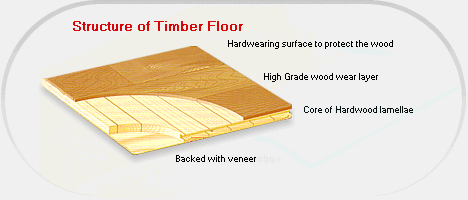Multi-layer Parquet 14.5 mm

Field of use and special characteristics
Advantages:
. Stable in shape and of the highest quality because of the strict requirements for moisture contents and climate-controlled production processes.
. Simple and quick to lay due to the high precision of its manufacture.
. Available in designs to suit every taste - over 40 different versions.
. Has a natural and beautiful appearance.
. Hard wearing lacquer.
. Easy to clean.
. Can be re-sanded several times.
Multi-layer parquet construction
Our floors are designed using the multi layer construction devised patented well over fifty years ago. This three-layer approach adds stability to the floors. The filets in the core are designed to move vertically when moisture is absorbed into the floor. At the same time the base layer and the decorative layer spread horizontally. This engineered system designed with the knowledge of how timber reacts to moisture ensures the floor expands and contracts in an even fashion. The end result is a stable fully engineered floor that will perform year in and year out.
Design Features
Single plank design. All our timbers are sliced to give a more authentic finish to the floor.
Three layer construction with tongue and groove.
The wear layer is made of sawn strips (not veneer)
The intermediate layer is made of lamells with vertical growth rings.
Thickness of the Wear Layer
3.6 to 4 mm approx.
Dimensions
3-strip and 2-strip boards: 1820 x 190 x 14.5 mm (shorter boards may occur)
Single strip boards: 1820 x 90, 145 mm x 14.5 mm
Surface treatment
- Ready lacquered with UV cured acrylic-based lacquer. No solvents or formaldehyde. The lacquer is very hard wearing and preserves the wood's natural appearance.
Sub-Floor
Multi-layer Engineered Floors are designed for installation on a flat sub-floor according to regulations HusAMA83Q 2 and RA 93 Hus Q2.2. The sub-floor must be dry, flat and stable. The sub-floor can be concrete, plywood, particleboard or timber.
Recommended Use
Commercial or domestic.
Laying
14.5 mm multi-layer parquet is laid as a floating floor in a three plank scattered configuration i.e.
1/3, full plank, 1/2 plank, this will randomly place end joins of the floor providing an authentic look. This laying pattern also adds to the stability and strength of the floor.
The boards are glued together at the tongue and groove by applying adhesive along the whole length of the boards. A moisture barrier and underlay are placed beneath the boards. The underlay acts to dampen the impact noise created by traffic. Total thickness of flooring system is 17.5 mm to 18.5 mm dependent on which acoustic underlay is used.
Floating floors are designed to expand and contract, as all timber subject to moisture will. The key to the stability of floating floors is controlling where they expand and contract. Often traditional timber floors subject to moisture will buckle and warp in line with their natural structure. The multi-layer system spreads the movement to the outside extremes of the floor.
An expansion gap of 10 to 15 mm around the walls and cabinetwork is provided to allow for this movement. The expansion gaps around the walls are hidden under the skirting board. We recommend false Kickers be used in cabinetwork. This will allow the floor to visually flow, rather than have unsightly mouldings or flex.
In the case of aluminium slider doors we recommend powder coating aluminium senior mouldings to the same colour as the doorframes. Again this gives the visual effect that the floor flows under the door as it would in a traditional platform construction. We also need to provide expansion gaps and mouldings in internal doorways and where the timber meets tiles or carpet. We offer a range of options to suit the decor/design of the project.
Moisture Content
The moisture content of the floor in its packaging is 7% 2%.
Weight
Approx. 8 kg/m2
Warranty
30 Years Structural guarantee - this is to say that the multi-layer system will not delaminate for a guaranteed period of ten years. This is conditional on the floor being subject to normal use. The warranty is not applicable where the floor has been subject to flood or misuse.
Care and Maintenance
Timber flooring is easy to clean. If the floor has surface dirt it is best to use an anti static mop. For caked on dirt, food spills and every day grime, use a damp mop. When cleaning the floor be careful not to use excessive amounts of water. Use a well rung mop so it is damp rather than wet and wipe over. Ideally we recommend using a vileda or similar mop. Use very hot water with a cap full of methylated spirits to help the moisture evaporate.
It must be remembered that timber floors are wood and wood can be affected by exposure to excess water.
1. Never use corrosive cleaning chemicals on timber floors.
2. Never use steel wool on the floor.
3. Never use polish, there is no need to, as the polish cannot penetrate the protective surface. We recommend Bona X as the cleaning agent for timber floors. Contact Trojan Timbers for advice on the nearest distributor of Bona X.
4. Place doormats at each entrance to help reduce dirt build up on the floor.
5. Place rugs in high traffic areas such as walk ways and hallways, etc.
6. Place cups under heavy furniture and soft furniture feet under everyday furniture such as dinning chairs, coffee tables etc. This will help protect the floor from damage through scratching.
Kempas |
Merbau |
Jarrah |
Jatoba |
|
|
|
|
Beech Natural |
Oak |
Vic Ash |
Steamed Beech |
|
|
|
|
|

